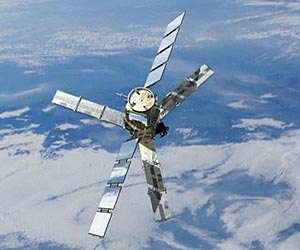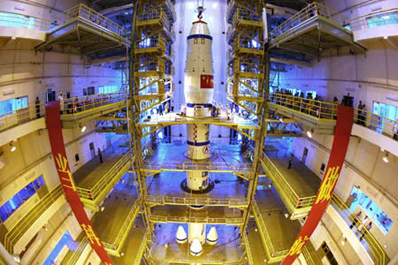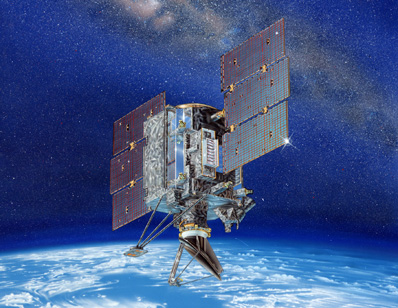Iran plans to launch its own satellite by 2011, since no one seems willing to help; Iran claims it is a communications satellite – Israel says it is a spy satellite.
[Fox News – 11/20/2009]

The MIRAS instrument on the European Space Agency’s SMOS satellite launched earlier this month, has been switched on and is operating normally – it will map soil moisture and ocean salinity.
[Space Mart – 11/20/2009]
Russia may delay maiden launch of the new Angara carrier rocket, designed to put heavy payloads into orbit, for at least one year due to shortage of funds from the Defense Ministry.
[Space Travel – 11/20/2009]
DirecTV announces completion of merger with Liberty Entertainment following Liberty Media stockholders’ OK for split of Liberty Entertainment; acquisition by AT&T or Verizon is a possibility.
[iStockAnalyst – 11/19/2009] – [Wall Street Journal blog – 11/20/2009]
NSR industry briefing sees the satellite-based earth observation market entering a phase of impressive growth, expected to generate $6.2B in satellite manufacturing, commercial data, and value added services in 2018.
[NSR – 11/19/2009]

President Obama and Chinese president Hu Jintao agree to expand and formalize U.S.-Chinese discussions on new cooperative space efforts at Beijing summit.
[Spaceflight Now – 11/18/2009]
Quick-thinking Chinese ground controllers able to maneuver high-value Chinese spacecraft out of path of space debris, marking first such save by China, and emphasizing the mounting orbital debris hazards faced by space-faring nations.
[Spaceflight Now – 11/18/2009]
DirecTV chooses Michael white, former vice chairman of PepsiCo, as new CEO; Echostar elevates Michael Dugan to CEO as Charley Ergen vacates the post.
[CED Magazine – 11/18/2009]
Iridium teams with three new partners to expand satellite services offering in Mexico.
[CNN Money – 11/18/2009]
Shuttle Atlantis successfully docks with International Space Station.
[Spaceflight Now – 11/18/2009]
ViaSat offers new Ethernet Service Expansion Module for its Enhance Bandwidth Efficient Modem that promotes Frequency Division Multiple Access across Department of Defense satellite networks.
[SatNews – 11/18/2009]
Sri Lanka signs agreement with Surrey Satellite Technology Limited of the UK to obtain an Earth Observation satellite, representing Sri Lanka’s first communications satellite.
[Space Mart – 11/18/2009]
NASA chief is ready to work with China on space exploration, as Beijing aims to send a manned mission to the moon by around 2020.
[Space Daily – 11/17/2009]
SES invests $75M in O3b to become a key shareholder, aiming to support development of the O3b high-speed satellite internet network.
[Satellite Today – 11/17/2009]
Gilat reports third quarter revenue decline, and announces hiring of former Intelsat General president Susan Miller as SIGS CEO.
[Satellite Today – 11/17/2009]
Spot LLC responds to budget conscious holiday shoppers by offering a $50 Holiday Rebate for the SPOT Satellite Personal Tracker, the award-winning personal and portable satellite-based communications messenger.
[CNN Money – 11/17/2009]
SatMax completes installation of Iridium satellite communications repeater systems for ITT Corporation; the Defense Department plans to use SatMAX systems indoors to provide non-line-of-site access to Iridium satellites.
[CNN Money – 11/17/2009]
Stratos Global is recognized by the World Teleport Association as the world’s largest independent teleport operator again in 2009.
[PR Newswire – 11/17/2009]
SpaceX protests U.S. Air Force contract award to Orbital Sciences Corp. for missile hardware.
[Satellite Today – 11/17/2009]
KVH TracPhone V7 and mini-VSAT Broadband service will be deployed by the United States Coast Guard on its 110 ft. and 225 ft. cutters.
[SatNews – 11/17/2009]
Spot Image Corporation and the U.S. Geological Survey have begun to distribute, over the internet, SPOT satellite data collected over North America between 1986 and 1998.
[SatNews – 11/17/2009]
Eutelsat and Asia Broadcast Satellite strike strategic agreement for cooperation at 75 Degrees East position in satellite orbital arc.
[PR Newswire – 11/16/2009]
Stratos Global expands its line of Stratos MobileLink fixed-to-mobile calling services, enabling fast, affordable connectivity from fixed locations to Iridium and Inmarsat mobile satellite terminals, to help customer avoid high tariffs charged by local telephone companies.
[SatNews – 11/16/2009]
Newtec’s Sat3Play and ASTRA2Connect internet connection rated EXCELLENT by leading independent German consumer organization group.
[SatNews – 11/16/2009]
TCS acquires substantially all of the assets of Sidereal Solutions, Inc., a satellite communications technology engineering, operations, and maintenance support services company.
[SatNews – 11/16/2009]

Atlas launch of Intelsat 14 is halted due to power interruption to Ordnance Remote Control Assembly; launch will be rescheduled following the space shuttle Atlantis launch.
[Universe Today – 11/15/2009]
NSR report – Global Satellite-Base Earth Observation – the industry has taken rapid strides in the last decade, reinventing itself by expanding application base from military and weather to industries including infrastructure, energy, and insurance.
[NSR Report – November 2009]
NSR Report – Global Assessment of Satellite Supply & Demand, 6th Edition – was Intelat’s purchase of ProtoStar-1 for $210M a good deal or not?
[NSR Report – November 2009]
FCC claims that cable and satellite set-top-boxes may be impeding the growth of broadband internet connectivity into homes.
[Washington Post blog Post Tech – November 2009]
WBMSAT PS – Satellite Communications Consulting Services






















